I am having trouble with my camera but here’s a quick and dirty tutorial on using the watercolor technique to make “torn paper” beads similar to the bead on the lower left.
1. Mix a palette. I always start a project by mixing a set of colors that “hang together.” Make at least one color in each hue family and add a mud color to create a palette that you like. You don’t need much clay – 1/2 oz of each color is plenty.
Option: Add a little bit of aluminum leaf to each of the colors. This adds a slight sparkle similar to mica in stones. I use aluminum leaf because it doesn’t tarnish.
2. Mix top colors.I like to marbleize three pea sized colors from my palette to make the top colors. I often include my mud in the mix. This mutes the starting colors so that the final watercolor sheets are more natural – not too “easter-eggish.” Run the clay at the thinnest manageable setting on the pasta machine to make a very thin sheet that is no bigger than 2″ x 3″.
Option: Do not mix the clay all the way – leave it a little bit mottled. This will add variations of color to the final sheet.
3. Add black and white. Sheet white and black at the thickest setting, stack them together, and then place the top color on the white.
There are many variations of this step. The basic idea is to “wash” the very thin top color over a thick sheet of white. This spreads the color so that it becomes lighter and brighter without actually mixing it with white clay. The black sheet is added to the bottom for contrast when the sheet is torn.
Option: Use an off-white such as ecru for the white layer, and a deep dark for the black layer. This option is often used by Judith Kuskin to make her beautiful jewelry
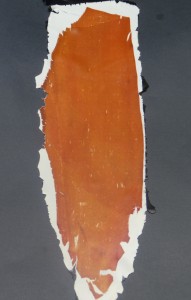 5. Wash the top color. Run the stacked sheets though the pasta machine starting with the thickest setting. Go progressively thinner until the sheet is very thin (and usually fairly long!) Mix different proportions of your palette colors to make many variations of watercolor sheets.
5. Wash the top color. Run the stacked sheets though the pasta machine starting with the thickest setting. Go progressively thinner until the sheet is very thin (and usually fairly long!) Mix different proportions of your palette colors to make many variations of watercolor sheets.
Notice how much lighter and brighter the washed color is compared to the original top color.
Option: If your colors are coming out too bright, add more mud to the top color.
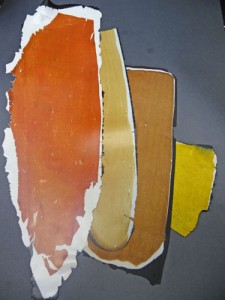 6. Select a color scheme. Looking at all your watercolor sheets, use your instincts to decide which colors to put together. Audition each color with the other colors and adjust proportions until the combination looks good to you.
6. Select a color scheme. Looking at all your watercolor sheets, use your instincts to decide which colors to put together. Audition each color with the other colors and adjust proportions until the combination looks good to you.
Before going on to the next step, lay the sheets out next to each other to see where there is lots of value contrast and where there is little. Don’t assume that all the colors will look equally as good against each other.
 7. Make mud. Because the sheets go lighter and brighter I usually use a dark color for my background. I keep my scrap clay sorted into three bins – blues and purples, greens and yellows (including oranges which are really just yellows with a little bit of red!) and reds and magentas. This makes it easier for me to mix clearer colors when I don’t want mud. When I do want mud, I pull a little bit from each pile taking more from the blues/purples if I want a gray mud, more from the green/yellows if I want an ocher mud, and more from the reds/magentas if I want a brown mud.
7. Make mud. Because the sheets go lighter and brighter I usually use a dark color for my background. I keep my scrap clay sorted into three bins – blues and purples, greens and yellows (including oranges which are really just yellows with a little bit of red!) and reds and magentas. This makes it easier for me to mix clearer colors when I don’t want mud. When I do want mud, I pull a little bit from each pile taking more from the blues/purples if I want a gray mud, more from the green/yellows if I want an ocher mud, and more from the reds/magentas if I want a brown mud.
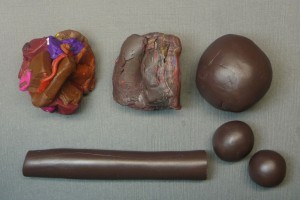 8. Make base beads from mud. To make base beads, mix some mud from scraps until it is all one color. Roll it into a ball while pressing all the air out. Roll the ball into a log and cut off chucks to make smaller balls.
8. Make base beads from mud. To make base beads, mix some mud from scraps until it is all one color. Roll it into a ball while pressing all the air out. Roll the ball into a log and cut off chucks to make smaller balls.
Option: If you want all your beads to be similar in size, measure and cut the same amounts off the log.
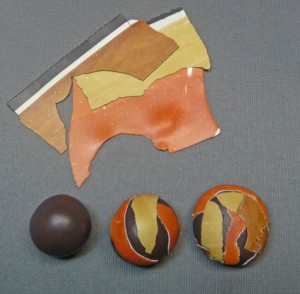 9. Collage torn sheets. Tear off small pieces of the watercolor sheets and collage them onto the bead blanks. I like to leave some of the dark background color showing for contrast. Gently roll the collaged sheets into the base bead and then form the bead into a shape you like. Pierce the beads before baking if you don’t want to drill holes after baking. Bake according to the clay brand instructions.
9. Collage torn sheets. Tear off small pieces of the watercolor sheets and collage them onto the bead blanks. I like to leave some of the dark background color showing for contrast. Gently roll the collaged sheets into the base bead and then form the bead into a shape you like. Pierce the beads before baking if you don’t want to drill holes after baking. Bake according to the clay brand instructions.
Option: Roll the beads with some cornstarch to make them smooth. Bake the beads on a bed of cornstarch to prevent flat spots.
Note: The beads and pendents at the top of this post are all older variations of the watercolor technique. The pivot beads from Chapter 2 are a new variation that uses a black, white and gray striped cane as the white layer. Play with making watercolor sheets using:
- A stretched out cane slice for the top color.
- Crumbly old white clay for the middle layer.
- A Skinner blend for the top color.
- A textured white piece for the middle layer.
- Mokume gane for the top layer.
- A dark color for the middle layer.
The possibilities are endless!
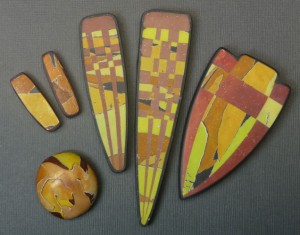

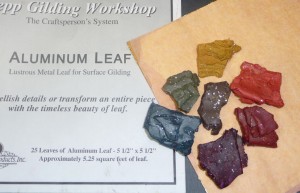
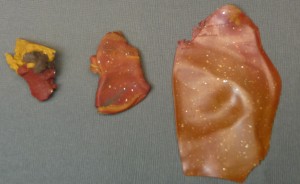
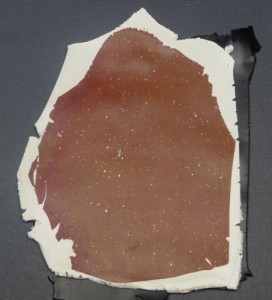
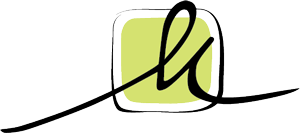
February 12, 2024 at 9:16 am
I think I started messing around with polymer clay about 12 years ago. It started as a girl scout project with my daughter’s troop. We made PC ornaments for christmas. Afterwards I played around with the leftover clay and was hooked. Your tutorial for watercolor technique was my first real “success” and I’ve gone back to it again and again over the years. Just wanted to say thanks after all this time for such a valuable and fun way to create depth and texture with predicatable results that leave a little room for fun surprises. Absolutely one of my favorites.
April 5, 2019 at 2:43 pm
Thank you so much for this very understandable tutorial. How generous of you. I really enjoy the outcome you achieved and can’t wait to try it.
October 18, 2009 at 7:02 am
Many thanks for this tutorial. I have always admired these beads and amazed that they were initially created quickly for submission to Ravensdale. In this case, creativity was in top form as the beads are gorgeous. I can imagine how much fun you had with the other (now famous) artists quickly making more beads! Good memories for all.
October 16, 2009 at 12:56 am
It looks fabulous, I can’t wait to try it out. Thank you!